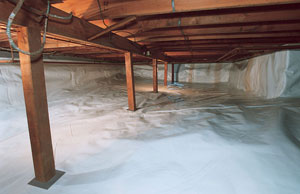In Business Since | License #
In Business Since | License #



Encapsulation transformation. A damp, dirt-floored crawl space is a liability to home energy performance, indoor air quality and building durability. The encapsulation process utilizes special waterproofing, air-sealing and insulating products to eliminate these problems.
For many years, standard residential construction methods called for crawl spaces to be ventilated by means of installing small air vents at regular intervals in crawl space walls. Standard residential construction methods also called for most crawl spaces to have dirt floors. The living space above the crawl space was commonly insulated by installing fiberglass batts between the joists above the crawl space.
Unfortunately, this method caused many problems with crawl spaces that affected the rest of the home. If your home is suffering from crawl space ventilation, Dr. Energy Saver can rectify the situation and provide you with proven solutions for crawl space energy efficiency. Contact your local dealer today!
This construction method prevailed primarily because it gave builders a quick, easy and affordable way to provide a solid foundation, using materials that were universally available. Unfortunately, vented crawl spaces create conditions that damage building materials, diminish energy efficiency, and force homeowners to deal with hazardous mold and pest infestations. Briefly, here's what happens in a vented crawl space: First of all, insects, mice, squirrels and other pests who enter the crawl space find fiberglass batt insulation to be an ideal habitat.
Moist outside air that enters a vented crawl space condenses on cooler surfaces in this under-house area, saturating wood framing and fiberglass insulation. Wet fiberglass has little or no R-value, and wet batts often fall out from between floor joists, ending up on the crawl space floor. Mold in the crawl space creates a health hazard by putting mold spores into the interior air; it also can cause wood to rot, eventually leading to structural damage.
Today building scientists and other building technology experts advocate strongly that crawl spaces be sealed or "encapsulated" rather than vented. They also recommend that fiberglass batt insulation be replaced with rigid foam insulation that is installed against crawl space walls. Unlike fiberglass, rigid foam insulation doesn't absorb moisture or support mold, and it won't compress, fall out of place or lose R-value once it's installed.
The encapsulation process, combined with proper crawl space insulation, effectively transforms a damp, dirty, moldy zone into a clean conditioned area that has a positive impact on comfort, energy efficiency and indoor air quality. Dr. Energy Saver is a leading provider of crawl space encapsulation across the country. Contact your local dealer today and find out how you could be saving with our crawl space and home energy solutions!
Looking for a price? Get a no cost, no obligation free estimate.